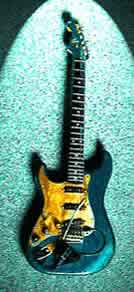Equipment and guitars etc.
The Guitar Synth’
Or to be more concise, the guitar activated synth’, personally, my favourite bit of kit of all time. “ Where is this bloke coming from!?” I hear you say, “ one minute he’s giving lots of retro, AC30’s, tone, response and such, and the next minute he’s on about the wonders of occilators!” Well, can I say that the connection for me is quite simple and logical and that is, the pursuit of sounds. I like AC30’s because they, sound good and I like gtr synths for exactly the same reason!
When you are thrashing your Strat into your amp, you just want it to reproduce and enhance the tone and sustain ect, of your instrument, (make it sound good). When you plug your Strat into a synth, it becomes the key to the door to a whole different way of generating sound and ultimately music. SOUNDS!
Purists have probably buggered off long ago (I hope!) so here’s a little insight into this very inspiring addition to the guitarist’s vocabulary.
How does it work?
Your standard (or superduper hot wired bluesmother) pickup is a microphone. It creates a magnetic field in which string vibration is registered in the form of sinewaves which are then shunted to your beloved amp and made much louder and then bunged through another microphone, wired in reverse, called a loudspeaker! The string, although producing a fundamental wave, also produces a collection of sub-harmonic waves caused by many things such as the neck, the body, the finish, the bridge and so forth all adding to the character of the guitar sound and easily amplified as noise.
The synthesiser only answers to yes or no, not maybe or possibly (harmonics). Easily done with a keyboard using each note as an on-off switch. Some extremely forward thinking person in the past realised that by applying a separate pickup to each string, you would reduce the harmonic confusion substantially and also pave the way for polyphony. So you have the Hex pickup, each string has it’s own pickup and output feed. The signals from the pickups are shunted down a multicore to a switching device called a ‘ Smitt Trigger’ which outputs, note on, note off, information. The information contained between, on and off, (the note played and duration) is then offered to what is commonly known as a CPU (central processing unit). Still here? This is where the pitch of the note played is analysed by it’s waveform and the equally important envelope, (the attack, length and decay) of the note. This information is then offered to the ADA (analogue to digital to analogue) converter which converts the analogue signals to a series of yes/no digital commands which are in turn offered to the sound generator (synth). The resultant digital noise is then converted back to an analogue signal so as to be able to be amplified in the conventional way! Simple isn’t it!
Does it work?
The simple answer is yes, but how well, is entirely dependent on One’s own expectations and ability to adapt to a new set of rules and limitations. The first generation Roland gtr synths were little more than polyphonic distortion units (GR 100, GR300) which were unstable in pitch and sounded awful! A massive improvement was achieved with their next offering, the GR700 which used the digital sound generating source from their JX3P keyboard with it’s digital occilators providing far greater pitch stability and of coarse, a fully programmable, polyphonic synth with memory storage. This is still a great tool believe me, and within it’s inherent tracking limitations, is capable of producing some quite stunning and startling sounds!
Over the past decade or so, the pitch detection and tracking capabilities have been vastly improved upon by Roland and others (notably Axon), so it’s far easier now to stretch your wings a bit but, clean picking is still rewarded with fewer glitches!
 Finally
the other control system of note was developed by Syntax and Stepp who
approach the problem of pitch detection and tracking completely differently.
Both have two sets of strings, fret strings and strum strings! These strings
have no acoustic properties whatsoever and purely operate switches under
the frets and under the strum strings. They are both without doubt the
fastest trackers ever, but, you’d better have ultra squeaky clean
picking technique as these mothers take no prisoners!
Finally
the other control system of note was developed by Syntax and Stepp who
approach the problem of pitch detection and tracking completely differently.
Both have two sets of strings, fret strings and strum strings! These strings
have no acoustic properties whatsoever and purely operate switches under
the frets and under the strum strings. They are both without doubt the
fastest trackers ever, but, you’d better have ultra squeaky clean
picking technique as these mothers take no prisoners!
Anyway, I love them all, god bless’em! The system I use at present with Full Monte (an improvised music Quartet) is : Roland GR50, GK2 pickup attached to my Mighty Mite custom Strat’, Simmons Midi mixer and an additional Yamaha TX81Z sound module, spaced out with a Digitech proccesor. It works for me!